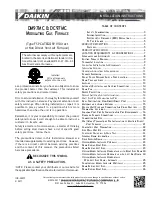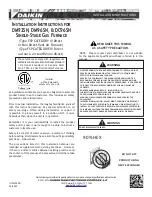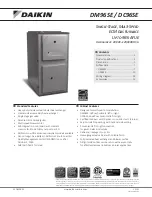
AGATWNPME01B: Installation Instructions
Manufacturer reserves the right to change, at any time, specifications and designs without notice and without obligations.
8
6. For All Horizontal applications:
Return air can only be connected to bottom opening of furnace. A
common return air plenum is required for proper auxiliary limit
switch operation.
7. Apply two factory-supplied foam strips to the back of each furnace.
Locate strips equal distance from top and bottom as shown in
. Trim off excess material.
8. Determine which side of furnace will be used to route external
extension harness. Remove 7/8 in. diameter accessory hole
knockouts in blower compartment side selected to attach harness to,
see
.
9. Position furnaces back-to-back on attic platform or suspended
supports. Adjust and shim each furnace to align both furnaces.
Follow all clearance to combustible material.
10. If furnaces are installed closer than 12 inches above a deck made
from combustible material, provide rollout protection as shown in
the furnace installation instructions. The bottom closure pan may be
used for this purpose.
NOTE:
DO NOT lay furnace down flat on the side that external
extension harness is installed. Raise furnace up a minimum of 1-1/2
inches (38 mm) above deck so harness does not rub on casing or deck.
11. Drill two 1/8 in. holes, approximately 1 in. (25 mm) below
discharge flange, from inside top of discharge opening and through
both furnaces, see
. Drill two 1/8 in. holes, approximately 1
in. (25 mm) below return air flange, from inside top of return air
opening and through both furnaces. (Use
12. Drive one factory-supplied No. 6 x 3/4 in. LG screw through each
hole and tighten until furnaces are secure and foam strips have
sealed gap between furnaces.
13. Connect return- and supply-air ducts to furnaces. Seal duct
connections to prevent air leakage.
14. Move 115V junction box JB in either furnace from left-hand side to
right-hand side if required. Refer to furnace installation instructions
for complete details.
15. Go to Section 3, Connect Electrical Components.
Horizontal, Stacked Together - for
Non-Condensing ONLY
For attic installations on a platform, see
:
1. Construct a platform from 3/4 in. (nominal) plywood, extending out
30 inches (762 mm) from the front of each furnace.
2. Maintain all clearances to combustibles per the furnace Installation,
Start-up and Operating Instructions.
3. Follow all additional building codes.
4. Long truss spans may require additional support along the bottom
chord of the truss. Consult the truss manufacturer’s guidelines for
engineering assistance.
5. Long rafter or attic joist spans may require additional support along
the bottom of the rafter or joist. Consult local or regional building
codes for design and loading requirements.
For suspended installations, see
. (Not recommended for wood
trusses unless approved by the truss manufacturer or other approved
engineering methods):
1. Furnaces may be suspended using two pieces of 1-1/2 in. x 1-1/2 in.
x 1/4 in. thick cold rolled angle iron underneath the furnaces and
four 3/8 in. diameter threaded rods.
2. Allow for at least 9 inches (229 mm) in front of each door for door
removal.
3. Each piece of angle iron must be secured to the bottom of each
furnace with at least two #8 x 3/4 in. sheet metal screws.
4. Maintain all clearances to combustibles per the furnace Installation,
Start-up and Operating Instructions.
5. Unistrut or similar material may be used, provided that the furnaces
do not sag in the middle or bend or twist at the support ends. The
support material must be secured to the bottom of each furnace in a
manner similar to securing angle iron to the furnace.
6. For all horizontal applications: Return air can only be connected to
bottom opening of furnace.
7. Apply two factory-supplied foam strips to mating side of each
furnace. Locate strips equal distance from top and bottom as shown
8. Remove 7/8 in. diameter accessory hole knockouts in blower
compartment from mating sides of furnaces.
9. Insert a plastic snap bushing through the 7/8 in. knockouts from the
outside of the casing.
10. Position furnaces on top of each other on platform or suspended
supports. Adjust and shim each furnace to align 7/8 in. diameter
holes in both furnaces.
11. Drill two 1/8 in. holes, approximately 1 in. (25 mm) below
discharge flange, from inside top of discharge opening and through
both furnaces, see
. Drill two 1/8 in. holes, approximately 1
in. (25 mm) above return air opening flange, from inside blower
compartment and through both furnaces, see
12. Drive one factory-supplied screw through each hole and tighten
until furnaces are secure and foam strips have sealed gap between
furnaces.
13. Connect return- and supply-air ducts to furnaces. Seal duct
connections to prevent air leakage.
14. Move 115V junction box JB in RH furnace (as viewed from the
upflow position) from left-hand side to right-hand side. Refer to
furnace installation instructions for complete details.
15. Go to Section 3, Connect Electrical Components.








































